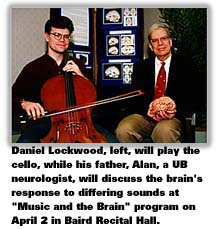| VOLUME 29, NUMBER 25 | THURSDAY, MARCH 26, 1998 |
Neurologist father/cellist son team up for program, 'Music and the Brain'
By LOIS BAKER
But for one evening, Alan Lockwood, a UB neurologist, and his 25-year-old son, Daniel, a cellist, would have us examine more closely what actually happens when those sounds creep in our ears.
They have organized a program called "Music and the Brain," which will be presented at 8 p.m. on April 2 in Baird Recital Hall. There will be no admission charge.
A specialist in brain imaging using a technique called positron emission tomography (PET), Alan Lockwood is conducting some of the newest studies of the links between the human auditory system and the brain. His research has shown heretofore unknown connections between the sites in the brain that register sound and those that control emotion.
Using these newest research findings, he will explore the brain's response to silence, and then discuss how and where the brain registers the pitch and intensity of sounds, including those of music, illustrating his points with brain scans that reveal neural activity.
Daniel Lockwood, playing his 1889 Vincenzo Postiglione cello, will demonstrate pitch and intensity, which will segue into an illustrated discussion of the brain's response to these differing sounds and the links between sounds and emotion.
The program will conclude with Daniel's performance of two movements of Johann Sebastian Bach's "Suite No. 2 in D Minor."
The father-and-son team represents an unusual intertwining of medicine and music. The senior Lockwood studied voice while a pre-med student at Cornell University-"I managed to sing all the way through medical school and my residency"- and helped found the Council for Visual and Performing Arts at the University of Texas Medical Center.
Through musician friends affiliated with the council, he learned that performers with instrument-related problems were going to Cleveland and elsewhere for treatment. "I thought that in this huge medical center, we should be able to treat these people," he said.
Lockwood educated himself in arts medicine, went on to found the Performing Arts Medicine Association, and published a definitive paper in The New England Journal of Medicine in 1989 on arts-related injuries. He continues that work at UB as director of the UB Performing Artists Clinic.
Looking for a way to combine his work on the auditory system and his interest in how the human brain enables music to become more than a series of pitches at different intervals, he enlisted his son's help.
A graduate of the Eastman School of Music and the New England Conservatory, Daniel Lockwood came to the realization at some point in his training that for him, the arts had meaning only in a larger context. He is now back in school at UB, preparing to apply to medical school.
"I always thought that if I weren't a musician, I'd be a doctor," he said. "Medicine will allow me to work with people and for people, to do something positive in life."
Daniel will discuss pitch and intensity of notes, and invite the audience to notice how a composer creates a work of differing parts, each having a distinct character, but with enough similarity to develop in the listener a memory of what they have heard and an expectation of what will happen next.
"The unconscious tension between these two realities creates the pleasure we derive from music," he noted.
Daniel has performed widely at music festivals, with the Slee Sinfonietta and the Fredonia Chamber Players, and continues to play private engagements.
Lockwood, a professor of neurology, nuclear medicine and communicative disorders and sciences, also is operations director for the UB-VA Medical Center for Positron Emission Tomography. His research that forms the basis for this program was supported by UB, the Center for Hearing and Deafness, the American Tinnitus Association, the James H. Cummings Foundation and the National Institutes of Health.
The program is presented by the departments of Music, Neurology, Nuclear Medicine and Communicative Disorders and Sciences
News Services Editor
Most people, when they listen to music, don't analyze its tone, pitch or intensity, or ponder how notes arranged in certain ways can make them feel joyous, nostalgic, sorrowful or elated. Most of us simply "...let the sounds of music creep in our ears...," as Shakespeare wrote in "The Merchant of Venice," and enjoy the result.
Most of us simply "...let the sounds of music creep in our ears...," as Shakespeare wrote in "The Merchant of Venice," and enjoy the result.
Current Issue | Obituary | Comments? | Archives | Search
UB Home | UB News Services | UB Today